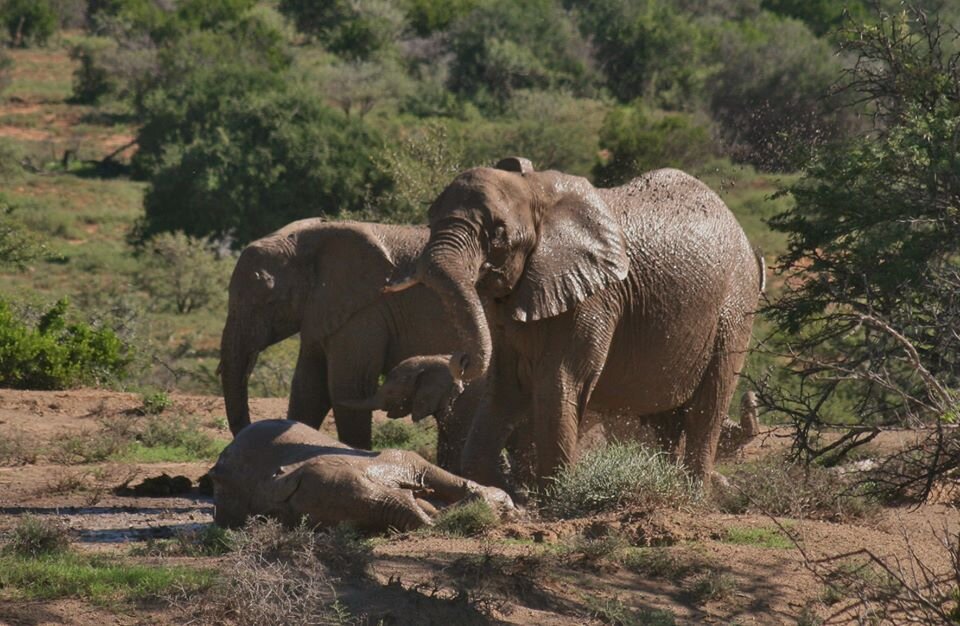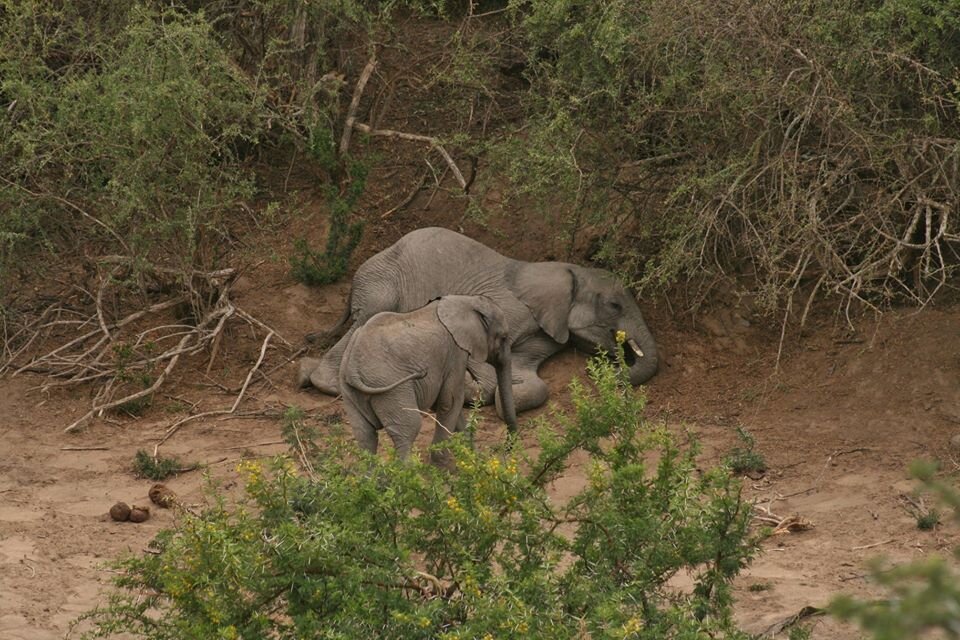Harry, Mount Camdeboo's elephant bull, spends a fair amount of time walking around independently of the herd these days. He joins up with the herd for a few hours, or a few days, and then they go their separate ways again. When they are in the same area, Harry often climbs higher up the mountain slopes to feed than the herd does. Harry is doing well and seems to have benefited fromthe summer vegetation.
The youngest member of Mount Camdeboo's herd is now two and a half months old
The youngest member of Mount Camdeboo's herd is now two and a half months old. The little calf is full of energy and delightful to watch! While the rest of the herd is feeding, the little one practises trying to pick things up with its trunk, kicks things around with its feet, investigates what the others are eating or tries to initiate a game with one of the other calves. Here, the little one is watching and listening to the rest of the herd, who were off to the side.
This is Lily, the youngest cow in Mount Camdeboo's herd.
This is Lily, the youngest cow in Mount Camdeboo's herd. She was using her trunk and mouth to break the leaves and branches off this tree. An elephant's trunk is an amazing appendage! It is flexible enough to twist and curl, but strong enough to break branches and delicate enough to pick up small objects off the ground. Elephants use their trunks to feed, drink, smell, scratch, shower, dust bath, greet, communicate, comfort, breathe. Such a useful organ is complicated to control though and learning to coordinate the muscles in their trunk effectively, takes an elephant years of practice.
This is Levi, standing next to his mom, the matriarch of Mount Camdeboo's herd
This is Levi, standing next to his mom, the matriarch of Mount Camdeboo's herd. Since his mother had a new calf a couple of months ago, Levi is now spending more time away from her and gaining independence. He does, however, still come to feed or stand close to her at times during the day, or if he is feeling nervous. Levi will remain protected by his mother and the herd for the many years of his development still to come.
At #ERP the life of every elephant and rhino matters.
Mud serves a functional purpose for elephants.
While coating themselves in mud serves a functional purpose for elephants, it seems to me that the act of taking a mud bath is a task elephants enjoy! Mount Camdeboo's herd quickly gathered in the mud when they discovered this mud pool. While some splashed and sprayed the mud onto themselves, others seemed to enjoy rolling around in it!
Watch Mount Camdeboo’s youngest two elephants gently playing!
Watch Mount Camdeboo’s youngest two elephants gently playing! The youngest, Lithemba, is only six weeks old and seems to be initiating the play. The older of the two, Laddie, is nearly two years old. Laddie is very tolerant and gentle with Lithemba, who, not long before this, was pulling Laddie's tail
Male elephants are often portraited as lone bulls
Male elephants are often portraited as lone bulls, keeping to themselves and only seeking out other elephants when in musth and when lured by females in estrous. This is not true though. Male elephants have associates or companions whose company they prefer above any others. These buddies only split up when one of them go into musth – even timing their musth so they do not overlap and risk having to fight each other.
Here is a great example of such a friendship – Kahle and Mvula at Samara Private Game Reserve.
Photo credit: Ida Hansen
Elephants can sleep standing up or lying down
Elephants can sleep standing up or lying down. In these photos, Laddie, the youngest member of Mount Camdeboo's herd, is walking over to his older brother to join him in a lie-down.
Harry, Mount Camdeboo's elephant bull
Harry, Mount Camdeboo's elephant bull, is a very peaceful elephant. He seems comfortable with the sound of human voices and the presence of people watching him. He even seems to be helping the herd, who are nervous at times, to relax when people are around.
How an elephant drinks water
Some think that elephants use their trunks as straws to drink. Though understandable, this is a misconception which is incorrect. What elephants do is that they suck water up in their trunk and then splash it into their mouths. A trunk, depending on the size of the elephant, can hold up to 12 litres of water.
These two boisterous boys at @mountcamdeboo have both mastered the skill of drinking with their trunks. Something that can be a daunting task for young elephants.
Photo credit: Ida Hansen










